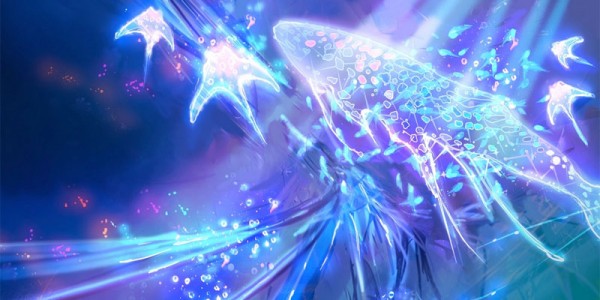
When a game reacts to the player with light and sound, I’m less inclined to call this innovation than I am to call it a game. The remarkable aspect about Child of Eden, successor to Tetsuya Mizuguchi’s first rhythm action game Rez, is the spectacle of it — like lighting fireworks then marveling at the bursts color and the pop of gunpowder. Child of Eden‘s story marvels at the magnificence of its own artistic medium (technology) while espousing caveats about sacrificing personality for efficacy. And the game finally provides justification for that expensive mess of motion control cameras, the Kinect, as one of the first titles to combine simple motion with strategic gameplay and do it well. Child of Eden is a complicated, narcissistic, firecracker techno concerto.
You are an antibiotic, and the Internet (Eden, of Rez) has been infected. The incandescent bacteria hold ransom the first digital human psyche reproduction that takes the form of an innocent, dark-haired girl in a flowery meadow separated into five personality spheres. Thankfully, Child of Eden doesn’t press the issue with narrative since the play mechanics drive its evocative nature. Just think neon Fantastic Voyage; the rest is “further reading”.
While in play, Child of Eden makes literal the subliminal affects of synesthesia, but not the other way around. Its self-love, a confident and necessary trait, stems from the explication of adventitious synesthesia, like the effect of garden variety psychedelics. But this acid trip is under control, and the interactive music isn’t an involuntary response but an illustration of one. It’s like calling a history textbook history; there’s intentional separation.

And in the context of video game history, Child of Eden is no revolution. Remember R-Type? Star Fox? Time Crisis? The on-screen element combines pre-existing ideas. Baddies cross into view and the player moves a reticle to them and shoots. Levels tunnel into boss battles (i.e. find the weak-spot, pew-pew). The integration of enemy hits with musical tones (Remember Guitar Hero?) adds to the aesthetic value, sure, just like the unbelievable, breathtaking luminescent creatures and vistas. But it’s the same game I’ve been playing since ColecoVision. Zaxxon, anyone?
The applause for Child Eden‘s development, then, should go to user interface, the Kinect controls. The right hand is a blue targeting reticle, activated by a sharp forward jab, and the left is a continuous, weaker stream of purple lasers. Two hands to the sky, the international sign for surrender, unleash extermination bombs that clear the field. And that’s it. It’s fluid, practically one-to-one, and it works. Some enemies can only be bested by purple, some only by blue. Most bacteria and environments interact with either, allowing for tactical exploration; later levels, especially boss battles, require frantic, precise hand alternation. If developers learn anything from Child of Eden, let it be that motion controls are made for simple motions. That’s where they shine.
In praising the basic, I don’t mean to slight the immersive nature of Mizuguchi’s design matrix (sound, movement, visuals) because there’s a sincere emotional component to each of the five levels in Child of Eden that will widen the eyes of attentive gamers. And despite the sometimes horrendous difficulty of fifteen-minute, no-checkpoint stages, my time in Eden brought out the kind of gaming joy that only comes from a fresh control-scheme perspective. Complexity, though, is not Child of Eden‘s “fruit of knowledge.” The unadorned pleasure of a unique artistic vision, the nirvana of a breathable, organic score, and a simple controller-free, hassle-free experience satisfy. Faked synesthesia and Internet children do not.


















